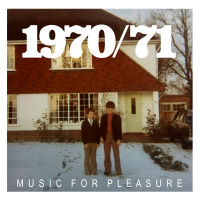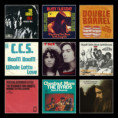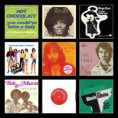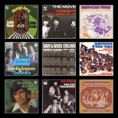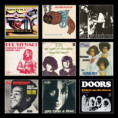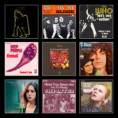It was on New Year’s Eve 1970 that Paul McCartney instructed his lawyers to issue a writ at the High Court in London that effectively ended the Beatles, so generating a period of mourning more akin to the death of JFK than a pop group. Not that the Beatles meant anything to me, my experience of them limited to a couple of singles hidden away in my father’s record collection and nursery rhyme songs like ‘Yellow Submarine’, ‘Ob La Di, Ob La Da’ and All You Need Is Love’ we were forced to sing at school assemblies. I knew nothing of the Beatles importance, or that their demise also represented the end of a pop era they’d kept focused for the past seven years. Nor did I care, because for me it was just the beginning.
It’s a fact that anyone who’s going to develop a love affair with pop always does so by the age of ten or eleven, twelve at the latest. On New Year’s Eve 1970 I had just turned eleven so was ripe for the picking, albeit that my interest in pop was nothing compared to my pre-occupation with football and motorbikes. Despite being one term in already, also dominating my thoughts was how I would continue to get through life in a new grammar school, ten miles and a forty minute coach ride away from my home in Earley on the eastern border of Reading.
In September 1970, having successfully passed the eleven-plus exam a year underage, I’d become a ten year old first year pupil at Theale Green. Instantly alienated from the local kids I’d grown up with and feeling useless, unworthy and very alone, I’d fallen in with some older classmates and for the first time had started to take an interest in the songs coming out of the radio in my father’s 1965 Vauxhall Victor.
Still in his thirties and with a varied taste in music that included a love for female singers like Dusty Springfield, Bobbie Gentry and Sandie Shaw, the radio would have been tuned into Radio One. Certainly, that’s where I heard ‘Lola’ by The Kinks and ‘Ruby Tuesday’ by Melanie, the first two songs I immediately wanted to hear again. And it was those two songs that would start the gradual drip, drip, drip that four months later would lead to 1971 and my realisation that pop could take me anywhere I wanted to go without leaving my head.
Now, history would have us believe that in the long list of pop years, 1971 was one of the worst. Given how young I was at the time, I wouldn’t know about that, but it was definitely a time of change. With music journalists and fans alike still in denial that the sixties really were over, the one thing that everyone did agree on was that the pop single was a thing of the past. Singles were for kids and housewives and whatever came next would be album sized. And in 1971 it was, records like The Rolling Stones Sticky Fingers, The Who’s Who’s Next, Led Zeppelin IV, Deep Purple’s Fireball, Black Sabbath’s Master Of Reality, Yes’s Fragile, Emerson, Lake & Palmer’s Tarkus, Genesis’s Nursery Cryme, even Marvin Gaye’s What’s Going On, heralding a heavier, far more serious age.
And yet, no matter what the long haired, bedenimed, pseudo intellectual’s with their headphones, expensive stereo systems and alphabetically filed rock and prog albums believed, my first step on the never ending path to musical nirvana would be the assorted jumble of lightweight fluff filling the top forty singles chart, Radio One, and having permanently borrowed my father’s portable radio, night time Radio Luxembourg. Within a couple of months I’d also started a record collection of sorts, not with singles or albums which were way out of the price range of my meagre pocket money, but with the budget, Music For Pleasure label, Hot Hits albums available from a revolving gold rack at my local Martins newsagent.
Optimistic and innocent, gloopy and sentimental, each volume featured twelve cover versions of recent chart tunes that included lightweight reggae, easy listening country, chicken-in-a-basket Motown and manufactured hits from songwriting teams like Roger Cook and Roger Greenaway and future glam masterminds Nicky Chinn and Mike Chapman. It made no difference to me, I thought they were all equally fantastic. Then came another, totally unexpected, life defining moment.
While the singles chart provided the occasional rock interloper like The Stones ‘Brown Sugar’ or Atomic Rooster’s ‘Devil’s Answer’, amongst the Holiday Camp singalong’s and bubblegum I was losing myself in, I couldn’t fail to notice a song that was immediately more alluring and magical. Hearing T. Rex’s ‘Get It On’ for the first time in July 1971 ultimately proved to be my key to the secret mysteries of pop power and rock’n’roll glamour. Watching Marc Bolan on Top Of The Pops a week later, the glitter sparkling beneath his eyes, was even more mind-blowing, so much so that I converted instantly, caught up in Marc Bolan’s web of wonder and the nascent glam revolution.
Looking to the future by hitching the fifties rock’n’roll of his youth to his gobbledygook, mystic, hippy lyrics, he discovered something that was completely new. Arriving at just the right moment, the twelve months from the release of ‘Ride A White Swan’ in October 1970 to Electric Warrior in September 1971 belonged to Bolan and his brilliant teen anthems, all ripe and ready for a generation awaiting their own teenage dream. Even now it’s impossible not to love them or be suckered in by their deceptively innocent boogie.
1971 was a year of incredible discovery and in more recent times its musical landscape has been lauded as hugely influential, albeit more for the ‘heritage’ rock albums it produced than the top forty pop I was into. The passage of time has also led to a long overdue re-evaluation of Marc Bolan and T. Rex following decades of ridicule. And that can only be a good thing because without him I know for sure that I would never have found Bowie, whose alien artfulness would lead me to a darker, far more thrilling place entirely, one that would influence not only my taste in music but everything about me. And yet, as strange as it may seem, nothing would have happened to me without the building blocks of Radio One, Top Of The Pops, Hot Hits, the selection of songs here and 1971: My year of perfect pop forever!
1. THE KINKS ‘Lola’ (Single A Side June 1970)
2. MELANIE ‘Ruby Tuesday’ (Single A Side August 1970)
The first two songs to really grab my attention, to my tender ears ‘Lola’ and ‘Ruby Tuesday’ were simply great tunes. At ten years old I had no idea that Ray Davies was singing about a transgender encounter or even what a transgender encounter was. As for Melanie’s version of the Jagger/Richards hit, I had never heard of The Rolling Stones and nor would I for a further eight months.
3. DAVE & ANSEL COLLINS ‘Double Barrel’ (Single A Side August 1970)
The foundation on which my love for reggae was built, ‘Double Barrel’ was just one of many curveballs I’d be hearing over the coming year, Ansel Collin’s swaggering ska instrumental transformed by toaster Dave Barker into a song bursting with energy and that magnificent double u, o, o, o.
4. C.C.S. ‘Whole Lotta Love’ (Single A Side September 1970)
The most obvious signifier of my interest in pop culture was my love for Alexis Korner and C.C.S.’s apocalyptic, big band version of Led Zeppelin’s ‘Whole Lotta Love’, a song so good that in 1973 it would be adopted as Top of the Pops emblematic theme tune.
5. T. REX ‘Ride A White Swan’ (Single A Side October 1970)
In the autumn of 1970 Marc Bolan was a long way from being the glam god he would soon become, appearing on Top Of The Pops to promote ‘Ride A White Swan’ in some dodgy denim dungarees. Coming in at just over two minutes long, the songs deceptively simple, neo-rockabilly groove had to be extended by producer Tony Visconti looping the ‘da da dee dee dah’ line at the end six times to reach the required length.
6. THE EQUALS ‘Black Skin Blue Eyed Boys’ (Single A Side November 1970)
The last of a string of hits for The Equals, a three black, two white, North London group led by Eddy Grant, the driving, insistent ‘Black Skin Blue Eyed Boys’ broke the rules by proudly proclaiming ‘the world will be half-breed’. In 1970 that was revolutionary in itself, although as a ten year old boy uneducated in racism or any of the other -isms of life, I was unaware of the true meaning behind it.
7. ASHTON, GARDNER & DYKE ‘Resurrection Shuffle’ (Single A Side November 1970)
8. THE BYRDS ‘Chestnut Mare’ (Single A Side January 1971)
9. GEORGE HARRISON ‘My Sweet Lord’ (Single A Side January 1971)
Foregoing my weekly copy of Shoot football magazine, the first record I ever bought was Hot Hits 4 in February 1971. Amongst the session musician versions of recent chart hits contained within were note perfect copies of ‘My Sweet Lord’, ‘Chestnut Mare’ and the bewitching and rollicking ‘Resurrection Shuffle’, the first song I felt was truly my own.
10. HOT CHOCOLATE ‘You Could’ve Been A Lady’ (Single A Side January 1971)
There are a number of artists and groups on this playlist who would stay with me for most of my seventies, certainly up to the advent of punk. When I first heard the hook laden but essentially vapid pop soul of ‘You Could’ve Been A Lady’, I would never have guessed that Hot Chocolate would be one of them but they were; Errol Brown and Tony Wilson’s songs becoming more and more personal before going full blown disco in 1975.
11. DIANA ROSS ‘Remember Me’ (Single A Side March 1971)
I had no notion of cool in 1971. If I had there’s no way I would have been listening to Diana Ross. Not long into her solo career and Motown supremo Berry Gordy’s masterplan to transform her into an all-round, showbiz entertainer with mass appeal, producers Ashford and Simpson wrote ‘Remember Me’ specifically for her, a song imbued with a soulfulness that remains rare amongst her many solo recordings.
12. RINGO STARR ‘It Don’t Come Easy’ (Single A Side April 1971)
The first ex Beatles to pique my interest were the two unlikely lads George and Ringo, but it was their former drummer who made the most impression with his glam bandwagon hit ‘It Don’t Come Easy’. To an eleven year old boy it sounded incredible and the best song to jump around to at the local church hall disco.
13. THE ROLLING STONES ‘Brown Sugar’ (Single A Side April 1971)
Sexist and shockingly offensive towards black women, if ‘Brown Sugar’ was written today the backlash would be immediate and damning. Nonetheless, as nasty and controversial as it was, ‘Brown Sugar’ is still considered one of the great rock’n’roll songs with an instantly recognisable riff and a mesmerising groove. I still find it odd to think that it was my introduction to The Stones and only then because of its high, number two, chart position.
14. JOHN KONGOS ‘He’s Gonna Step On You Again’ (Single A Side April 1971)
As someone who grew up on the top forty and Top Of The Pops, throughout my adolescence I believed in the myths and legends of pop, the glitz and the glory, the wetting of knickers, the debauched, deathly lifestyle and the penniless, slightly crazed, one hit wonder who would end their life penniless behind closed curtains in the flat next door. I loved them all but I especially loved John Kongos and his tribal ‘He’s Gonna Step On You Again’ and ‘Tokolshe Man’, despite the fact that he was a two not a one hit wonder, and rather than end his life in the flat next door, he chose to spend it working anonymously in a recording studio.
15. NEIL DIAMOND ‘I Am I Said’ (Single A Side April 1971)
In the early seventies Neil Diamond led a weird double life as either a serious singer songwriter type or a Las Vegas showman. ‘I Am I Said’, his often forgotten, existential master work about displacement, loneliness and despair, solidified his reputation as the former while conveniently helping me forget the latter and his catalogue of karaoke favourites.
16. BOB & MARCIA ‘Pied Piper’ (Single A Side April 1971)
17. ERIC DONALDSON ‘Cherry Oh Baby’ (Single A Side May 1971)
18. GREYHOUND ‘Black And White’ (Single A Side May 1971)
I have a surprising number of people to thank for encouraging my initial interest in pop music, from my father to my older classmates at Theale Green. But someone who was more important than any of them was my neighbour Sue from two doors down. A year older than me, we would have many coming of age adventures together in our early teenage, but in 1971, while I was still messing around with manufactured top forty fluff, she had already graduated to the pop reggae hits and misses of late sixties and early seventies. As a result, I have her to thank for introducing me to the original single versions of Bob & Marcia’s ‘Pied Piper’, Greyhound’s ‘Black And White’ and my own favourite, Eric Donaldson’s ‘Cherry Oh Baby’.
19. MUNGO JERRY ‘Lady Rose’ (Single A Side May 1971)
20. THE MOVE ‘Tonight’ (Single A Side May 1971)
21. MEDICINE HEAD ‘(And The) Pictures In The Sky’ (Single A Side May 1971)
Mungo Jerry, Medicine Head and the soon to be no more Move were typical of the long haired and bearded, denim and cheeseclothed outfits populating the charts in the early seventies, their singles too rock for the teenyboppers but not rock enough for the serious, heads down, heavy brigade.
22. ATOMIC ROOSTER ‘Devil’s Answer’ (Single A Side May 1971)
It’s strange to think that alongside the standard chart fare played on daytime Radio One you could also hear a prog single as deliciously dark and enigmatic as Atomic Rooster’s ‘Devil’s Answer’. Even stranger was that being completely oblivious to the glimpse into the tortured mind of songwriter Vincent Crane the song provided, I would carry on regardless, tapping my toes and singing along like it was ‘Chirpy Chirpy Cheep Cheep’!
23. DAVE & ANSEL COLLINS ‘Monkey Spanner’ (Single A Side June 1971)
Dave and Ansel’s second big hit of 1971, ultimately ‘Monkey Spanner’ would prove to be even more influential.
24. THE SUPREMES & THE FOUR TOPS ‘River Deep, Mountain High’ (Single A Side June 1971)
Berry Gordy’s coupling of a struggling Four Tops with a rejuvenated Supremes may have been opportunistic, cynical and in some ways desperate, but it was the first time I’d heard the Phil Spector classic. In fact, their spirited rendition might even be preferable to the slightly overwrought Ike & Tina original.
25. LOBO ‘Me And You And A Dog Named Boo’ (Single A Side June 1971)
26. NEW WORLD ‘Tom Tom Turnaround’ (Single A Side June 1971)
No matter how much I liked their extreme humability, by the summer of 1971 MOR tunes like ‘Me And You And A Dog Named Boo’ and ‘Tom Tom Turnaround’ were beginning to lose their lustre. Always a serious thinker, even at eleven I realised that I needed something a little more challenging than ‘Me and you and a dog named Boo / Travellin' and livin' off the land / Me and you and a dog named Boo / How I love bein' a free man’ or ‘Tom Tom turnaround / Don't ever let me down / Don't ever leave my life / Tom Tom Turnaround / Don't ever let me down / Please take me for your wife’?
27. CURVED AIR ‘Back Street Luv’ (Single A Side June 1971)
A strikingly attractive hippy singer fronting the prog as prog could be Curved Air, Sonja Kristina wrote a song based on her own experience as an ex-convent girl who seduced a married ex-convict and took it to number five in the charts. With very few fiercely independent female role models around in such a blatantly sexist and misogynistic business, where women were ‘chicks’ and their intelligence in comparison to men seriously questioned, she was a rare shining light for both girls and boys.
28. DELROY WILSON ‘Better Must Come’ (Tighten Up Volume 5 LP July 1971)
29. DAVE & ANSEL COLLINS ‘My Best Girl’ (Double Barrel LP July 1971)
Two albums released to cash in on the pop reggae boom, Double Barrel was essentially the infamous title tune and ‘Monkey Spanner’ plus a mishmash of Dave Barker and Ansel Collins solo work, Barker’s wonderfully soulful ‘My Best Girl’ the only song to come anywhere near the quality of the hits. Inevitably, Trojan Records Tighten Up Volume 5 compilation was a more interesting and varied snapshot of early seventies rocksteady and reggae, Delroy Wilson’s classic ‘Better Must Come’ topping a bunch of seminal and surreal selections by the likes of Clancy Eccles, Dennis Alcapone and The Maytals that fried my tiny mind. Borrowed from my neighbour Sue, albums like these gave me access to a Jamaican culture that would remain elusive to most British kids.
30. T. REX ‘Get It On’ (Single A Side July 1971)
The first single to literally change my life, ‘Get It On’ would become Marc Bolan’s signature tune and no wonder. As witchy as ‘Hot Love’ (a single I’d been too inexperienced to appreciate six months earlier) but more playfully erotic and enticingly glittery, it was helped enormously by Bolan’s lyrics, his beguiling imagery (‘Well, you’re built like a car / You’ve got a hubcap diamond star halo’) adding a touch of dazzle to an already brilliant record.
31. ROD STEWART ‘Reason To Believe’ (Single AA Side July 1971)
32. C.C.S. ‘Tap Turns On The Water’ (Single A Side August 1971)
33. THE SUPREMES ‘Nathan Jones’ (Single A Side August 1971)
I spent most of my first year of pop infatuation alone in my bedroom with the curtains closed and the joss sticks burning, miming along to my Hot Hits albums with my silver star, hardboard guitar. Hot Hots 6 was a huge favourite, as was Hot Hits 7 and its spookily accurate versions of Rod Stewart’s ‘Reason To Believe’, C.C.S.’s ‘Tap Turns On The Water’ and The Supremes ‘Nathan Jones’. It was all a part of the make believe world I had created to avoid the sheer drabness of my reality as a grammar school kid living in smalltown England. Whereas once I had dreamt of being a superstar footballer, in 1971 I was a genius adolescent pop star of untold musical skill and talent in abundance. In reality, even with two years of piano lessons behind me, I struggled to play a tune.
34. AL GREEN ‘Tired Of Being Alone’ (Single A Side August 1971)
The first time I saw Al Green was on Top Of The Pops singing ‘Tired Of Being Alone’. It was just him on his own and was absolutely astonishing. Wearing a horrendous, typically seventies stretch top, he sang as if his whole life depended on it. While I didn’t realise it at the time, it was my introduction to soul. Sure, I’d heard the Motown pop production line of Diana Ross, The Supremes and The Four Tops, but somehow I knew instinctively that Al Green was the real thing.
35. CHER ‘Gypsies, Tramps & Thieves’ (Single A Side August 1971)
Another strikingly attractive and strong woman, in 1971 the 25 year old Cher had yet to escape the constraints of her adulterous and controlling husband Sonny Bono and the insipid folk rock that had made her name. Even so, ‘Gypsies, Tramps & Thieves’ was everything I wanted in a single, a thrusting showstopper with a huge chorus that raised questions about racism, prostitution and teenage pregnancy via the tale of a traveller family. It really was, indeed still is, fabulous.
36. THE DOORS ‘Riders On The Storm’ (Single A Side August 1971)
By the time I got to hear The Doors Jim Morrison was already dead, his road of excess leading not to the palace of wisdom as he believed, but to a heart attack in the bath. Of course, in the summer of 1971 I knew nothing of either Jim Morrison or his fate. But I was learning fast, so when ‘Riders on the Storm’ began to creep up the singles charts, I knew damn well that the undefinable otherness it possessed would lead to a place sonically and lyrically I had never been before.
37. T. REX ‘Cosmic Dancer’ (Electric Warrior LP September 1971)
With my interest in pop music increasing exponentially week by week, I was keen to hear as many records as I could lay my hands on. In the autumn of 1971, hypnotised by its stark black and gold sleeve, I borrowed a copy of Electric Warrior, the first ‘proper’ album I ever listened to. Featuring ‘Get It On’, the album cast a spell that is as spellbinding now as it was then. From the slinky thump of ‘Mambo Sun’ and ‘The Motivator’ to the Bolan origin story ‘Cosmic Dancer’ and the poignant ‘Life’s A Gas’, Electric Warrior introduced me to the wonder and magic of the album. And what magic it was. Better records would follow, but none of them, not even Bowie, would affect me in quite the same way.
38. SLADE ‘Coz I Luv You’ (Single A Side October 1971)
I was never much of a Slade fan, but I did like ‘Coz I Luv You’. Rougher, therefore more preferable, than their regular full on stomps, it benefitted greatly from the fact that Noddy Holder’s cuddly bear persona was not yet fully formed while Jim Lea’s violin added a nasty, even menacing edge, something they would never have again.
39. THE WHO ‘Let’s See Action’ (Single A Side October 1971)
In 1971, with Pete Townsend 26 and Roger Daltrey 27, The Who were on the verge of growing old. And yet, after the revelations of T. Rex and The Doors, I knew enough to know that they were far more significant than just another chart group. One of a trio of singles from Townsend’s aborted Lifeboat project, ‘Let’s See Action’ and its message of not accepting your lot in life and working hard to change it, was a fabulous introduction to a group I should have liked significantly more than I did.
40. DEEP PURPLE ‘Fireball’ (Single A Side October 1971)
From its unconventional start with the sound of an air con unit being switched on, ‘Fireball’ was supercharged, high speed, rock’n’roll and I loved it. Not that I would get to hear much more of Deep Purple. By the time I had enough cash to buy albums regularly a couple of years later, they were already on the slide.
41. FACES ‘Too Bad’ (A Nod Is As Good As A Wink…To A Blind Horse LP November 1971)
It sounds slightly ridiculous now given his questionable history, but Rod Stewart was an ever present in my early adolescence due to my best friend inheriting a box of Faces and solo albums from his sister. Whether it was their shambolic, often lewd and lusty, rock’n’roll burlesque or the gravel voiced Rod’s tender and world weary wonderment that made those records so fantastic I don’t know. But I have many happy memories of lounging around listening to An Old Raincoat Won’t Ever Let You Down, First Step, Gasoline Alley, Long Player, Every Picture Tells A Story, A Nod’s As Good As A Wink, Never A Dull Moment and Ooh La La, as consistently good a collection of albums as you’ll find anywhere.
42. T. REX ‘Jeepster’ (Single A Side November 1971)
From January 1971 until January 1973 Marc Bolan had a remarkable, two year run of four number ones and four number twos before ’20th Century Boy’ blew it in March 1973 by stalling at number three. Built on Willie Dixon’s ‘You’ll Be Mine’, ‘Jeepster’ was irresistible and possibly the best of the lot.
43. LAURA NYRO & LABELLE ‘The Bells’ (Gonna Take A Miracle LP November 1971)
My 1971 wasn’t all about the top forty and Top of the Pops. Empowered and encouraged by what I’d been listening to all year, I began to explore my father’s eclectic record collection, albums like Bobbie Gentry’s The Delta Sweete, Dusty Springfield’s Dusty In Memphis, Pentangles Sweet Child and Laura Nyro’s spine tingling versions of her own ‘favourite teenage heartbeat music’ on Gonna Take A Miracle providing me with an element of variety and sophistication I’d never have heard otherwise.
44. THE CHI-LITES ‘Have You Seen Her’ (Single A Side December 1971)
A church hall disco, slow dance staple for most of my seventies, somehow The Chi-Lites managed to encapsulate the ever-so-slightly creepy sound of adolescent heartbreak in a little over five minutes of schmaltzy gorgeousness and a fuzz guitar.
45. DAVID BOWIE ‘Oh You Pretty Things’ (Hunky Dory LP December 1971)
I didn’t get to hear Hunky Dory when it was released on 17th December 1971, a week before my twelfth birthday, but I did get to hear ‘Oh You Pretty Things’, my first Bowie song. Already familiar due to heart throb Peter Noone’s rinky dink, hit version earlier in the year, Bowie’s original was played on the radio as soon as it appeared, mostly the Hunky Dory version but there was also an older recording for Radio One’s Sounds From The Seventies.
I loved ‘Oh You Pretty Things’ more than any other song here so immediately set to work recording it onto a C60 with the Sony cassette player I’d been given as a birthday present. It may even have been the first song I recorded onto cassette, a rite of passage every music obsessed, seventies adolescent would take, and for me an incredibly liberating way to end such a transformative eighteen months.

